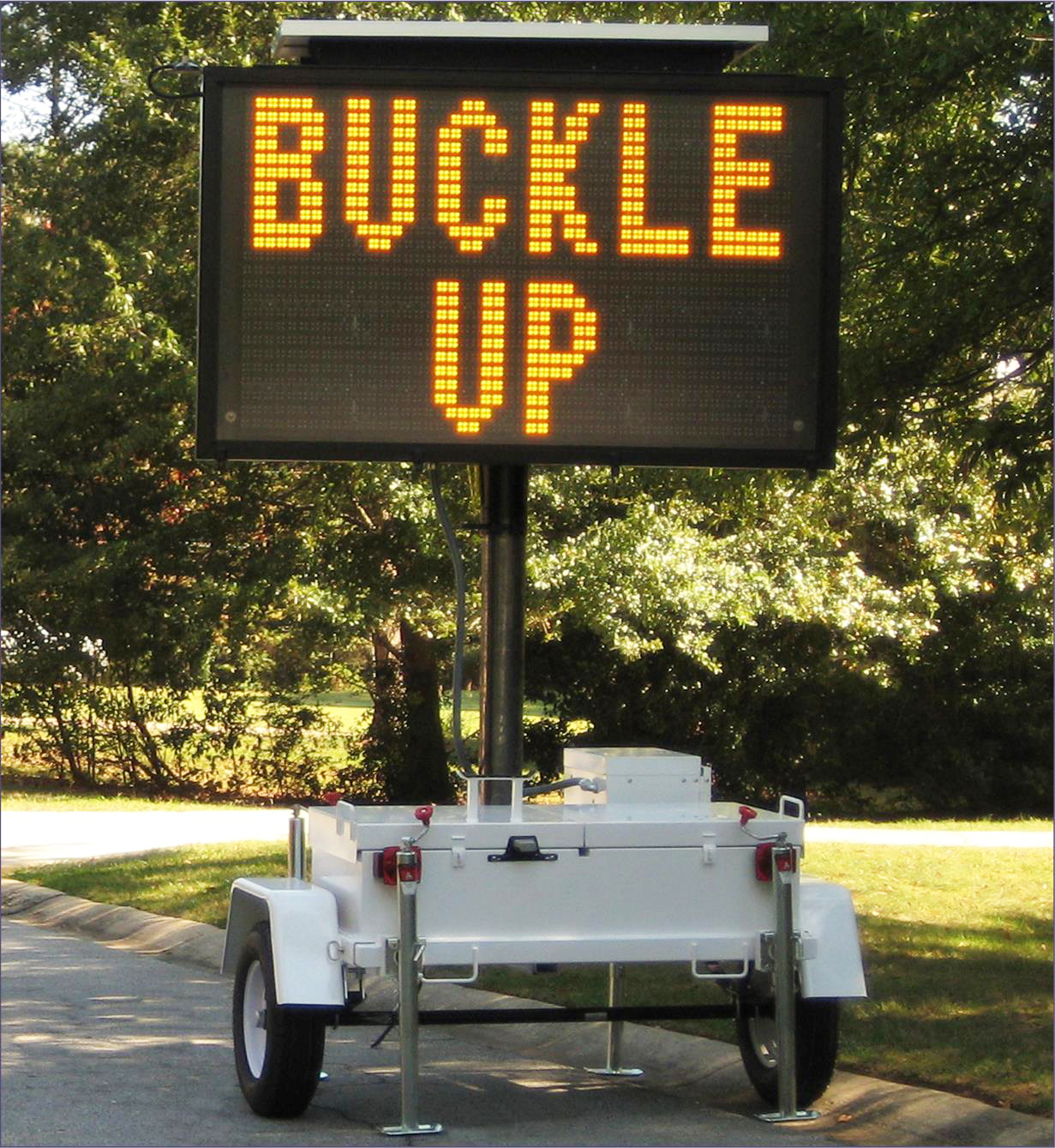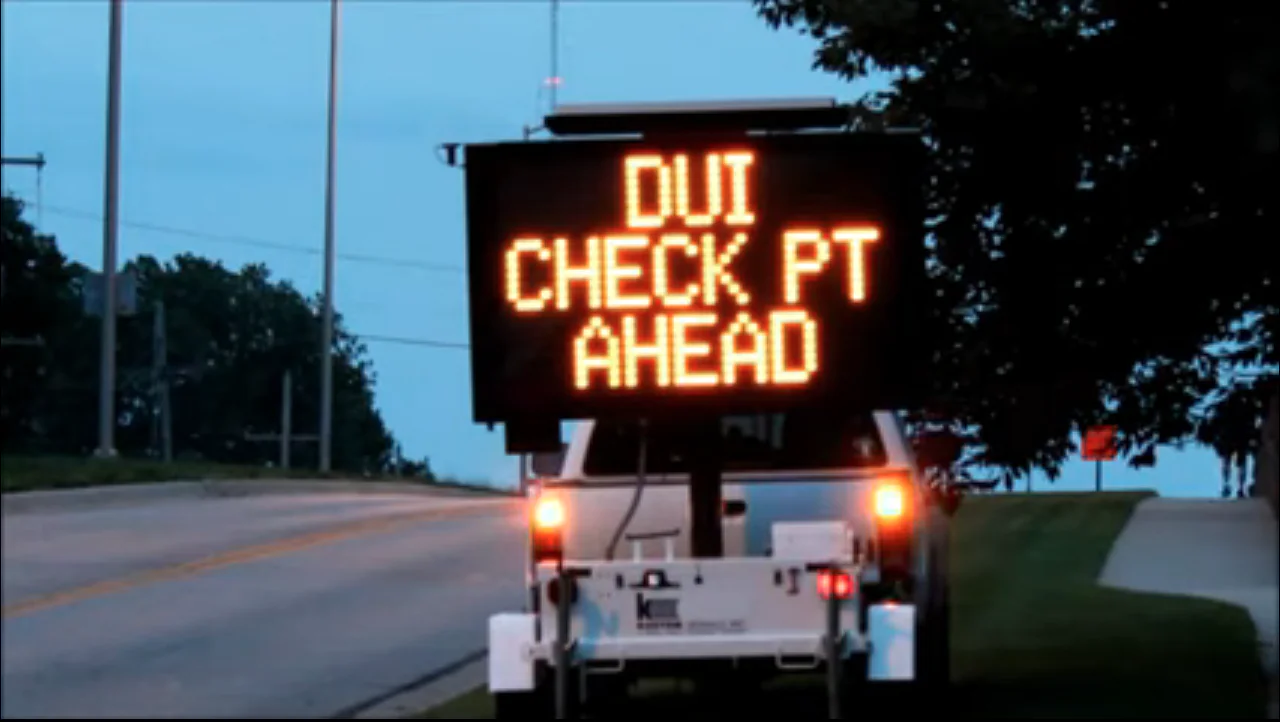VMS (Variable Message Signs) are digital road signs that have many aliases: CMS, DMS and EMS, which stand for changeable, dynamic, and electronic message signs, respectively. These signs use LED lights that display messages to commuters. They are usually fixed to a pole or overpass but can also be mobile-mounted on trailers and vehicles.
Signs can be programmed onsite, in advance, or controlled remotely, where they can be updated in a real-time fashion as they may be equipped with a modem. Portable message signs can be battery operated (run times of up to 60 days) or have the environmentally-friendly option of being solar-powered, providing weeks of extended deployment without the need to be recharged.
VMS has a wide range of uses, including but not limited to notifying drivers and passengers about: extreme weather, vehicular accidents, fugitives at large, road works, road and exit ramp closures, road debris, and traffic. They also serve as reminders to the public of travel regulations: from the ‘click it or ticket’ prompt, to reminding drivers of the speed limit, to alerts on reducing speed so that drivers can protect themselves, their passengers, cyclists and schoolchildren. When equipped with RADAR, VMS can even provide speed-triggered feedback messages. VMS does it all. Let’s take a look at two uses of VMS that exemplify their usefulness.
Guiding Drivers
Variable messaging signs were introduced in the 1950s and, in their initial rollout, were used across the US. But those traversing the New Jersey turnpike were one of the first to see a VMS in action.
Almost 70 years later, in November 2019, New York State concluded a project where 300 additional variable message signs and cameras were installed on major highways. Their relevance has increased during that time, as the digital signs can now be paired with cameras to promote accountability among drivers and help law enforcement identify drivers who commit traffic infringements.

VMS units can also be used to combat more specific traffic issues. A research team at Florida State University has put together two reports, which they then presented to the Florida Department of Transportation, on wrong-way highway crashes. One of the researchers, Walter Boot, said that “Wrong-way crashes are rare, representing only about 3% of highway crashes, but they are 27 times more fatal.”
The two reports were done with the intention of discovering the causes of this problem and determining solutions that could be implemented by the state. The researchers are now looking at measures to mitigate these tragedies, with VMS at the forefront of their strategy. They assert that more warning and attention-grabbing signs need to be placed ahead of exit ramps, among other spots on the roadway, to alert motorists to changes in their route.
Additionally, there is an overwhelmingly positive sentiment around VMS use by motorists, with many people disliking when they see signs turned off or with a blank display, thinking that it is a waste of money and potential. This sentiment is also present outside of the US, where the use of VMS is commonplace.
In the UK, the signs are called Matrix Signs, with a study conducted among UK drivers finding that VMS reduces driver stress, diverting people to alternative routes and saving them time. Another study, this time carried out across European cities, pinpointed that VMS was able to improve travel times, reduce the environmental impact of cars, and are thought of as ‘helpful’ by the public.

Finding our children
Variable message signs also play a crucial role in the Amber Alert system; established in 2000 as a tool to help recover missing children. It was named after 9-year-old Amber Hagerman, who was abducted on January 15th, 1996 and whose body was recovered some three days later.
In the United States, 75% of children who are kidnapped and murdered by a stranger are killed within the first 3 hours after abduction. The Amber Alert system is described by the US Department of Justice (DOJ) as a “partnership among law enforcement agencies, broadcasters, transportation agencies, and the wireless industry to activate an urgent bulletin in the most serious cases of child abduction.” The alerts are issued over the radio, on television, to smartphones and on VMS to attract the attention of motorists who may be able to tag the vehicle of the kidnapper.
The alerts have very strict criteria for activation to ensure that they are not overused or become a nuisance to the public. According to the DOJ’s annual report, as of May 2020, 988 children had been rescued specifically because of an Amber Alert.
And according to the DOJ’s 2018 report, of the 161 Amber Alert cases during that year, 34 children were successfully recovered as a direct result of a person who saw/heard an Amber Alert. In 45 out of 120 cases (travel data was only available for 120 of the 161 cases), 45 of those cases had the kidnapper leaving the city where the kidnapping was committed.
In fact, kidnappers have been known to cross state lines as well. In September of 2018, a 14-year-old girl from Surprise, Arizona, was kidnapped by a 21-year-old man who was later arrested. She was discovered 350 miles away in Mesquite, Nevada, as a result of an Amber Alert. This shows the vital job of VMS (both portable and fixed) in Amber Alerts, as they cover long distances and engage commuters in helping law enforcement catch a criminal on the loose.
Another accessory that can be paired with a VMS is an Automated License Plate Recognition (ALPR) system. ALPR uses technology that can recognize, from afar, alphabetical and numerical characters on license plates to track vehicles and assist law enforcement. As well as identifying traffic violations, the tech can also help to apprehend burglars, kidnappers, child traffickers and rogue motorists that have committed a hit-and-run. When used in conjunction with VMS, APLR can save law enforcement time and manpower. The state of California has been using APLR for a few years now to supplement their Amber Alert system.
Similar to their use for traffic advisories, the public has a positive perception of the use of VMS for these alerts. Amber Alerts also exist in Canada, Mexico, Ecuador and the UK, as well as in many US states and other countries that call the alert by another name; using the opportunity to pay tribute to a local child who was unfortunately abducted and not found in time. All these territories use VMS to get the word out.

